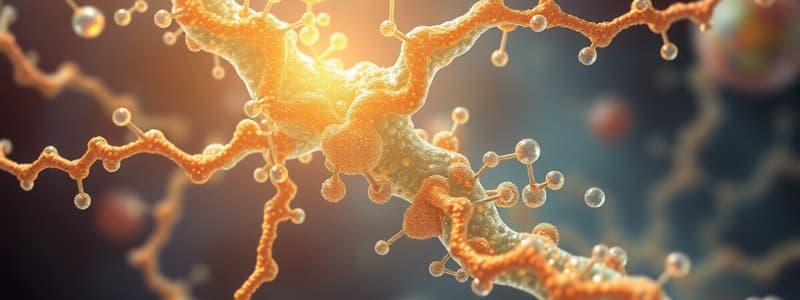Podcast
Questions and Answers
What is the primary function of glycoproteins in the cell?
What is the primary function of glycoproteins in the cell?
- Energy storage
- Protein degradation
- Water binding
- Cell-surface recognition (correct)
Proteoglycans are primarily composed of proteins.
Proteoglycans are primarily composed of proteins.
False (B)
What are the two types of carbohydrates mentioned in the content?
What are the two types of carbohydrates mentioned in the content?
Starch and Glycogen
Glycoproteins are proteins with __________ covalently attached.
Glycoproteins are proteins with __________ covalently attached.
Match the following structures with their descriptions:
Match the following structures with their descriptions:
Which type of glycan is associated with blood group A?
Which type of glycan is associated with blood group A?
The primary function of glycosaminoglycans is to provide lubricating properties to mucous secretions.
The primary function of glycosaminoglycans is to provide lubricating properties to mucous secretions.
What is the most common posttranslational modification of proteins?
What is the most common posttranslational modification of proteins?
Which blood group is associated with the absence of both GalNAc and galactose?
Which blood group is associated with the absence of both GalNAc and galactose?
Humans can digest cellulose efficiently due to specific enzymes.
Humans can digest cellulose efficiently due to specific enzymes.
What are the two main types of glycosidic bonds found in plant carbohydrates?
What are the two main types of glycosidic bonds found in plant carbohydrates?
The enzyme that disrupts α(1->4) bonds in digestion is called ___(a), and it breaks down oligosaccharides and disaccharides into monosaccharides.
The enzyme that disrupts α(1->4) bonds in digestion is called ___(a), and it breaks down oligosaccharides and disaccharides into monosaccharides.
Match the following transporters with their functions:
Match the following transporters with their functions:
Which of the following is not a classification of carbohydrates?
Which of the following is not a classification of carbohydrates?
A glycosidic bond occurs between two polysaccharides to form a disaccharide.
A glycosidic bond occurs between two polysaccharides to form a disaccharide.
What is the general formula for carbohydrates?
What is the general formula for carbohydrates?
The simplest form of carbohydrates is called a ______.
The simplest form of carbohydrates is called a ______.
Match the following types of carbohydrates with their characteristics:
Match the following types of carbohydrates with their characteristics:
Which of the following is an example of a structural polysaccharide?
Which of the following is an example of a structural polysaccharide?
Fructose and glucose have the same chemical formula but different structures.
Fructose and glucose have the same chemical formula but different structures.
What type of carbonyl group do aldoses contain?
What type of carbonyl group do aldoses contain?
A ______ is formed when two monosaccharides are joined together.
A ______ is formed when two monosaccharides are joined together.
Which carbohydrate serves as a storage form in plants?
Which carbohydrate serves as a storage form in plants?
Flashcards
What are carbohydrates?
What are carbohydrates?
Carbohydrates are a group of carbonyl compounds (aldehydes or ketones) that contain several hydroxyl groups.
What are monosaccharides?
What are monosaccharides?
Monosaccharides are simple sugars that cannot be broken down further.
What are disaccharides?
What are disaccharides?
Disaccharides are formed by the combination of two monosaccharides joined by a glycosidic bond.
What are polysaccharides?
What are polysaccharides?
Signup and view all the flashcards
What are aldoses?
What are aldoses?
Signup and view all the flashcards
What are ketoses?
What are ketoses?
Signup and view all the flashcards
Name some common monosaccharides.
Name some common monosaccharides.
Signup and view all the flashcards
Name some common disaccharides.
Name some common disaccharides.
Signup and view all the flashcards
Name some common polysaccharides.
Name some common polysaccharides.
Signup and view all the flashcards
What is the difference between glycogen and starch?
What is the difference between glycogen and starch?
Signup and view all the flashcards
Starch
Starch
Signup and view all the flashcards
Amylose
Amylose
Signup and view all the flashcards
Amylopectin
Amylopectin
Signup and view all the flashcards
Proteoglycan
Proteoglycan
Signup and view all the flashcards
Glycosaminoglycans (GAGs)
Glycosaminoglycans (GAGs)
Signup and view all the flashcards
Glycoprotein
Glycoprotein
Signup and view all the flashcards
Glycosylation
Glycosylation
Signup and view all the flashcards
Mucin
Mucin
Signup and view all the flashcards
Carbohydrate digestion
Carbohydrate digestion
Signup and view all the flashcards
Why humans can't digest cellulose
Why humans can't digest cellulose
Signup and view all the flashcards
What is SGLT-1
What is SGLT-1
Signup and view all the flashcards
Blood glucose regulation
Blood glucose regulation
Signup and view all the flashcards
What is hyperglycemia?
What is hyperglycemia?
Signup and view all the flashcards
Study Notes
Carbohydrates Overview
- Carbohydrates are a group of carbonyl compounds (aldehydes or ketones) that also contain several hydroxyl groups.
- Carbohydrates have the general formula (CH₂O)ₙ.
- Isomers have the same formula, but different structure.
- Fructose and glucose have the formula C₆H₁₂O₆.
Carbohydrate Objectives
- Recognize the general structure of carbohydrates
- Classify carbohydrates
- Recognize disaccharides
- Recognize polysaccharides
- Explain carbohydrate-modified protein structures and functions
- Explain carbohydrate digestion
Carbohydrate Classification
- Classification by number of units: monosaccharide, disaccharide, oligosaccharide, polysaccharide
- "-ose" suffix is added to name monosaccharides.
- Type of carbonyl group: aldose, ketose
- Number of carbons: triose, tetrose, pentose, hexose, heptose, nonose
Important Monosaccharides Examples
- Aldoses
- 5 carbons: Aldopentose sugars (e.g., ribose, xylose)
- 6 carbons: Aldohexose sugars (e.g., glucose, mannose)
- Ketoses
- 5 carbons: Ketopentose sugars (e.g., ribulose)
- 6 carbons: Ketohexose sugars (e.g., fructose)
More Carbohydrate Information
- Deoxyaldoses: A hydroxyl group (-OH) is missing in these sugars
- Acetylated amino sugars: N-acetyl groups are added to the structure; examples include N-Acetyl-D-glucosamine (GlcNAc) and N-Acetyl-D-galactosamine (GalNAc)
- Acidic monosaccharides: Contain carboxyl groups (-COOH); examples include D-glucuronic acid (GIcUA) and L-iduronic acid (IduUA).
- Sugar alcohols (alditols): When an aldehyde group is oxidized, it becomes an alcohol; examples include D-sorbitol and D-mannitol.
Disaccharides
- Two monosaccharides joined by a glycosidic bond.
- Examples: maltose (glucose + glucose), lactose (galactose + glucose), sucrose (glucose + fructose).
Polysaccharides
- Polymers of monosaccharides.
- Examples:
- Cellulose: Structural component in plants
- Starch: Energy storage in plants
- Glycogen: Energy storage in animals
- Chitin: Structural component in fungi and exoskeletons of insects
Protein-Carbohydrate Structures
- Carbohydrates can combine with proteins.
- Proteoglycan: Negatively charged heteropolysaccharide (GAG) chains linked to a core protein.
- Glycoproteins: Proteins with oligosaccharides attached.
Glycoprotein Functions
- Cell-cell communication
- Cell-surface recognition
- Antigen display associated with blood types
- Important for immune system reactions
- Components of extracellular matrix (ECM)
Carbohydrate Digestion
- Enzymes cleave glycosidic bonds.
- Alpha-amylase in the mouth and intestines breaks down alpha glycosidic bonds in starch.
- Humans lack enzymes that degrade beta glycosidic bonds in cellulose.
Carbohydrate Absorption
- Monosaccharides (glucose, fructose, galactose) are absorbed from the small intestine into the bloodstream.
- Different transport proteins (e.g., SGLT-1, GLUT-2, GLUT-5) are used for different monosaccharides.
Carbohydrate Metabolism
- Blood glucose concentration is maintained around 5 mM (90 mg/dL).
- Important for normal brain function.
- Lower levels can lead to confusion, coma, and higher levels can lead to vascular damage.
Studying That Suits You
Use AI to generate personalized quizzes and flashcards to suit your learning preferences.
Related Documents
Description
Test your knowledge on glycoproteins and carbohydrates in this biochemistry quiz. Questions cover their functions, structures, and involvement in blood groups. Explore glycosaminoglycans and bond types to deepen your understanding.




